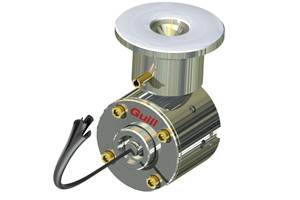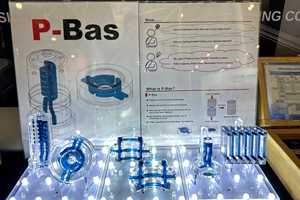Moving Die Parts Change Profile Shapes 'On the Fly'
Change one tubing lumen into two, or two lumens into three, or even split one tube into two in a “Y” shape: These are some of the dramatic alterations that can be made “on the fly” with a novel articulated die concept available for license from Specialty Silicone Fabricators, a medical tubing maker in Paso Robles, Calif.
Change one tubing lumen into two, or two lumens into three, or even split one tube into two in a “Y” shape: These are some of the dramatic alterations that can be made “on the fly” with a novel articulated die concept available for license from Specialty Silicone Fabricators, a medical tubing maker in Paso Robles, Calif. It builds dies with moving components capable of extruding profiles that transform continuously from one shape to another.
Specialty Silicone’s shape-shifting Geotrans (geometric transition) die technology has been used so far only for the company’s silicone rubber tubing, but it can be licensed for non-medical thermoplastic applications.
Moving die parts
Specialty Silicone has patented a number of dies with moving parts:
- Continuous “Y”-shaped lumen has one lumen that splits into two or three inside a continuous tube.
- Lumens can start and stop, previously accomplished only by welding plugs in a secondary operation. This tooling (U.S. Patent 6,394,141, May ’02) raises and lowers tines in the die mandrel.
- Three moving die sections make a one-piece, “Y”-shaped tube (U.S. Patent 5,945,052, Aug. ’99) with one inlet tube that transforms seamlessly into two. Previously such tubes could be made only by welding individual tubes onto a molded “Y” connector, with the inherent risk that the welds could come apart. Specialty Silicone has even built dies to transform one tube into three.
- A one-piece surgical drain changes shape from a small round tube with 3/16-in. OD into a wide, flat hollow profile 10 x 4 mm and then back again (U.S. Patent 5,549. 579, Aug. ’96). The single lumen transforms from round to a flat oval with ribs on one side that keep the flat lumen from collapsing. The mandrel is round in front, sloping smoothly into a flat oval with lengthwise ridges on one side. As the mandrel oscillates back and forth in the die, it changes the lumen from round to ribbed oval. At the same time, die plates outside of the profile move in and out to reshape the outside from round to flat and back, keeping nearly constant wall thickness.
- Specialty Silicone’s latest tooling (patent pending) creates spirals inside a profile. For example, multiple lumens can loop or twist around each other inside a solid tube to prevent kinking. Spirals are made with a linear sequence of two or more “tortuous conduits,” threaded to give different cross-sections.
A solid panel can also be molded in the die wall in the form of a spiral baffle to provide static mixing or turbulent flow. “The lumen spins, stops, then spins in the other direction. The spirals go one inch in one direction, then reverse and spiral one inch in the other direction,” explains v.p. of R&D Charles Schryver, co-inventor of the dies. “Then the wall between the two lumens stops, and the two lumens flow together.”
- Specialty Silicone’s first patent simply creates tubing with a constant ID and variable OD (Patent 5,511,965 April ’96). This can produce catheter tubes with stiff, thick sections and thin, flexible sections. Variable OD is made by moving a ring forward and back against the die plate to alter the gap between the die opening and mandrel.
Good for thermoplastics?
An unanswered question is whether Specialty Silicone’s moving-die technologies will work with thermoplastics. Commercial designers and makers of profile dies for both silicones and thermoplastics give a qualified “yes.” Shear and viscosity requirements are similar, they say, except that thermoplastic extrusion provides continuous flow, while silicone extrusion can start and stop. Silicone dies need cooling channels, and thermoplastic dies need heating channels. Neither can be used in moving die parts.
“My gut feeling is that it could be done,” says James Rathert, general manager at die maker Genca. “But it would be complex.” He notes that moving parts could create pockets where thermoplastics could burn, while silicone doesn’t degrade in the die.
Related Content
'Hybrid' Die Design Eliminates Weld Lines, Cuts Stagnation
NPE2024: Newest extrusion tool retains benefits of previous design and adds features to boost quality.
Read MoreMedical Tubing: Use Simulation to Troubleshoot, Optimize Processing & Dies
Extrusion simulations can be useful in anticipating issues and running “what-if” scenarios to size extruders and design dies for extrusion projects. It should be used at early stages of any project to avoid trial and error and remaking tooling.
Read MoreNew Rotary Die and Cam Lock Design for Tubing
NPE2024: New design enables quick and easy assembly and disassembly of the crosshead, and eliminates the socket head cap screws.
Read MoreBonding, Sintering Tech Advances Metal Bonding for Mold, Die Components
NPE2024: Punch Industry USA exhibits P-Bas, intended to replace the use of 3D printers when producing mold and die components, as well as a variety of mold component supplies.
Read MoreRead Next
Beyond Prototypes: 8 Ways the Plastics Industry Is Using 3D Printing
Plastics processors are finding applications for 3D printing around the plant and across the supply chain. Here are 8 examples to look for at NPE2024.
Read MoreMaking the Circular Economy a Reality
Driven by brand owner demands and new worldwide legislation, the entire supply chain is working toward the shift to circularity, with some evidence the circular economy has already begun.
Read MoreSee Recyclers Close the Loop on Trade Show Production Scrap at NPE2024
A collaboration between show organizer PLASTICS, recycler CPR and size reduction experts WEIMA and Conair recovered and recycled all production scrap at NPE2024.
Read More












